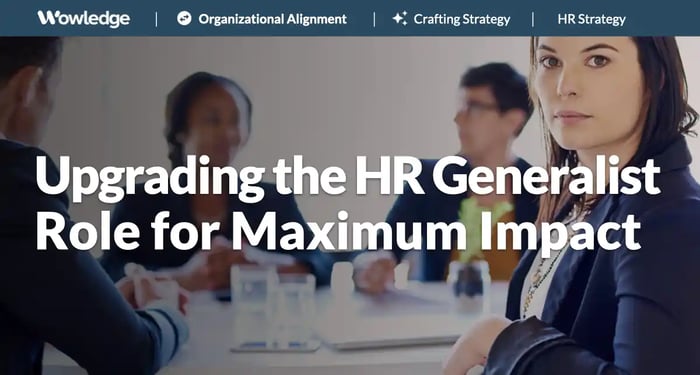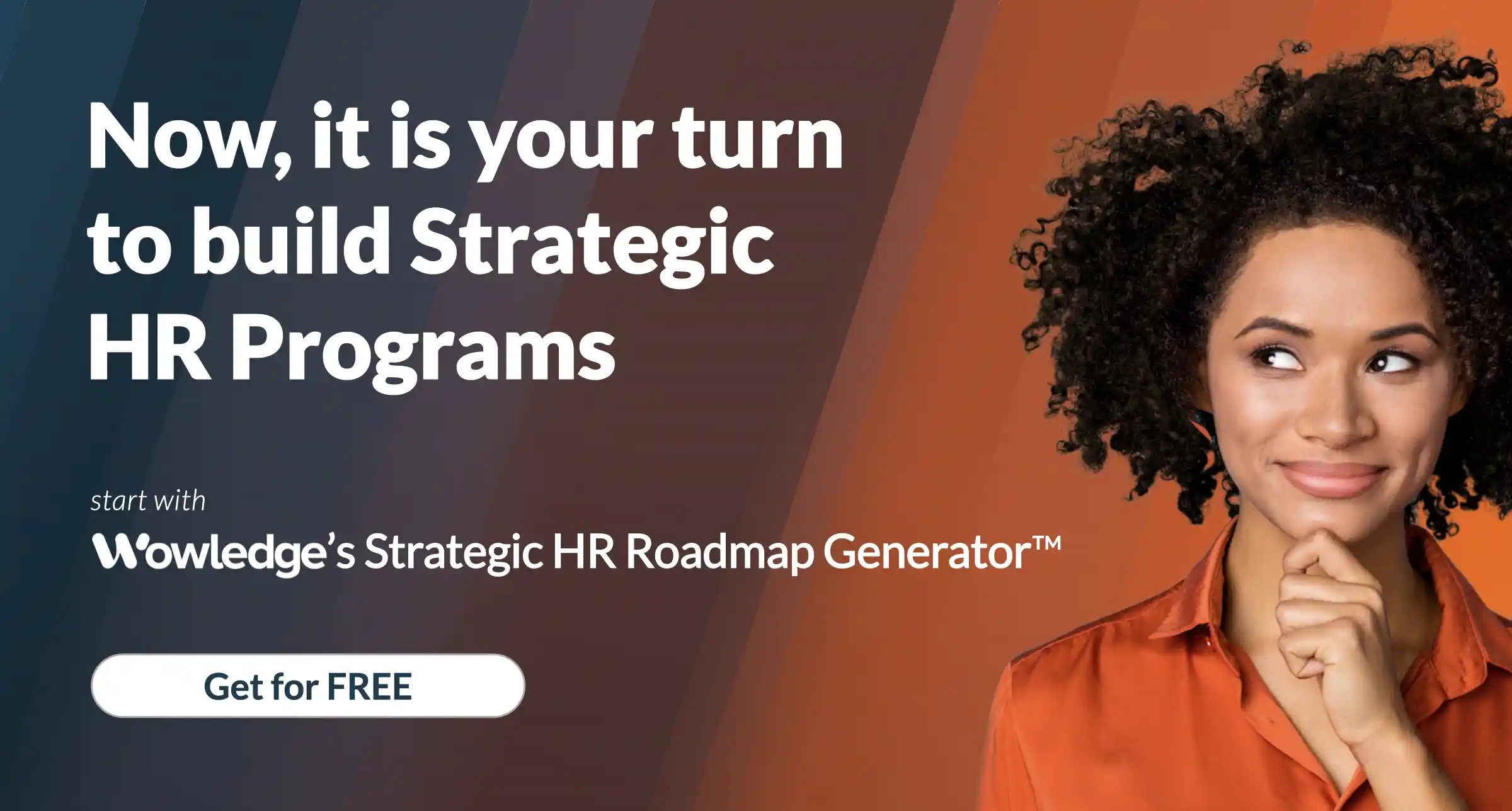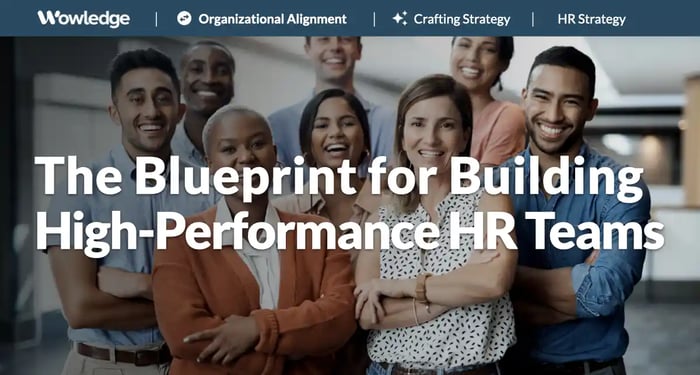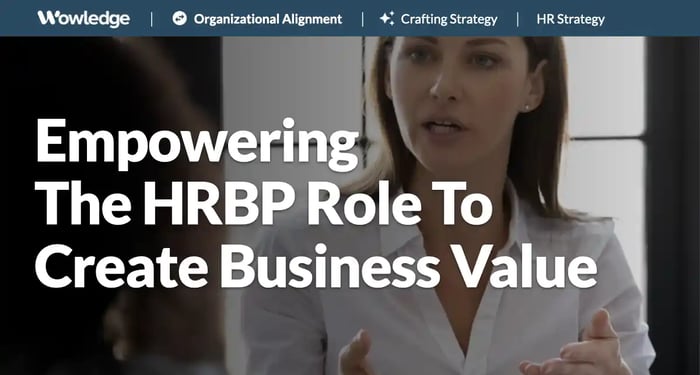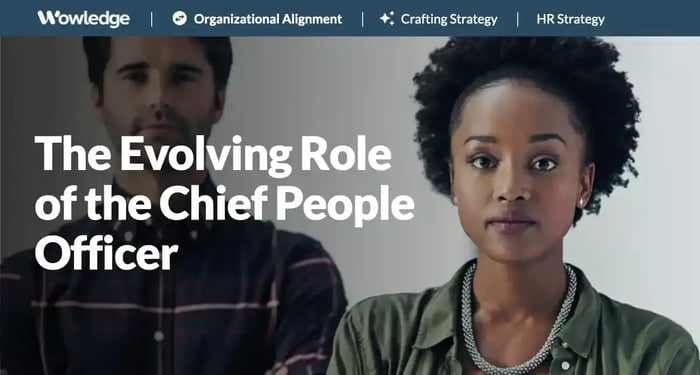Table of Contents
- Understanding the HR Generalist role
- Limitations and issues with HR Generalists
- The strengths and advantages of the HR Generalist role
- Evolutionary shifts affecting the HR Generalist role
- Deploying HR Generalists most effectively
- 1. Hire the right professionals for those roles
- 2. Place HR Generalists strategically
- 3. Focus performance where it offers the greatest value-add
- 4. Develop professional depth
- 5. Provide targeted business training
- 6. Build business and future skills through continuous learning
- 7. Create project opportunities
- Relevant Practices & Tools
- About Wowledge
Despite its widespread deployment across industries and organizations of all sizes and maturity levels, the value proposition of the HR generalist role has been questioned and challenged at times as an outdated artifact of 1970s and 80s-era HR organization models. Despite the exclusion of these roles in new and emerging HR operating models by leading industry thought leaders, researchers, and futurists, there are currently postings for over 17,000 jobs on LinkedIn, Glassdoor, and Indeed combined. Understanding that the U.S. Chamber of Commerce estimates that over 99% of companies in the U.S. have fewer than 500 employees, the need for multi-skilled HR generalists in small-to-medium businesses capable of handling a wide range of duties and responsibilities will continue.
As HR teams cope with budget pressures and reduced staffing levels, “doing more with less” remains a major theme. Understanding how to best differentiate, prepare, and leverage the HR generalist role can be of enormous value in positioning the function as a difference maker in achieving business and operational goals.
Understanding the HR Generalist role
An HR generalist is a professional-level individual contributor who typically reports to an HR Manager or Director. This non-management role is positioned as (primarily, but not exclusively) a one-stop shop for HR process and initiative execution, employee and line manager support and inquiries, employment law compliance, and talent management practice implementation in support of an assigned portion of a business unit, facility, or function. Traditionally, individuals in an HR generalist role communicate, facilitate, and guide local compliance with HR policies, recurring processes (recruiting and selection, onboarding, performance evaluation, merit pay cycle, annual benefit reenrollment), and employee relations case management.
They are responsible for coaching and advising managers on individual and team performance, employee engagement, worker pay and advancement, and handling employee discipline and discharge issues. They further provide guidance and advice to employees on training and development options, career and mobility opportunities, handling disputes and disagreements, and fielding questions and complaints related to unfair or discriminatory treatment.
As the primary point of contact for employees and their managers within an assigned business unit, function, or location, they are expected to handle manager and employee questions and requests and provide timely, accurate information and interpretations of policies, procedures, programs, and legal or regulatory requirements. They may be required to oversee and approve changes to employee files and records (e.g., job title, pay level, department transfers, promotions), and to manage the recording and reporting of legally required transactions and incidents related to health and safety, as well as non-discriminatory hiring and treatment.
The range of HR activities for those in an HR generalist role is expansive and requires a basic-to-moderate level of knowledge and expertise across many HR disciplines. As a result, these often require at least 3-5 years of progressively more responsible experience across multiple HR specialty areas. Consider the expertise that they must develop, access, update, and exercise:
- Recruitment and hiring. Conducting, advising, and overseeing the application of job descriptions and classification levels, candidate sourcing and screening, interviewing, recruitment process coordination, background verification, salary level decisions, and onboarding processing and orientation.
- Employee (and union) relations. Providing direction, tutoring, oversight, and approvals for performance management and coaching, managerial behavior expectations and standards, investigations and resolutions, policy and legal training, contract negotiations and compliance, discipline and discharge decision support, legal defensibility, and exit interviews.
- Benefits administration. Communicating, processing, and administering welfare, retirement, and savings benefit plan enrollment meetings; employee support; vacation and paid time off (PTO) administration; vendor systems and support; and promoting plan changes and enhancements.
- Compliance and policy adherence. Reporting, management, investigations, and claims processing related to wage and hour, equal employment (EEO), affirmative action (AAP), health and safety (OSHA), Workers’ Compensation, FMLA plans, data security and protection, and related laws and regulations.
- Performance and merit compensation process management. Monitoring practice and process design, and the refinement of goal-setting, performance standards, evaluation criteria, decision-making, appraisal accuracy and fairness, and monitoring of compliance with organization-level merit and bonus pay distribution standards and budgets.
Limitations and issues with HR Generalists
It comes as no surprise that, given the title of HR generalist role, the job holders might be subject to overwhelming requirements, confusing and overlapping responsibilities with their functional specialist peers, and overly shallow levels of skill and preparation. Common issues that often become barriers to the delivery of high-quality support and guidance are substantial and can create serious reputational and legal risks for the organization. Consider these common challenges facing HR generalists:
Breadth without depth
The role, as designed, is often akin to that of a “jack of all trades, master of none.” Many generalists, especially in their early years in the role, find themselves needing to understand enough about how a process operates and what outcomes need to be achieved, without necessarily understanding its foundational underpinnings (e.g., how a job is levelled and placed in a pay range). This limits their ability to understand the root causes of a situation or provide guidance and direction in more nuanced cases. The risk is providing incomplete, insufficient, or incorrect decision support, as the expertise lies in process management and execution rather than in underlying theory, policy, and practice.
Focus on the tactical and administrative
Despite the widely promoted and supported notion and objective of HR as a strategic partner, the HR generalist's duties and responsibilities focus on HR process execution, overseeing managerial and employee participation in HR processes, and providing internal “customer service.” As such, their skills in process administration, detailed policy expertise, and interpersonal influence and interaction skills are prioritized over strategic or operational contributions. In that way, internal perceptions of the HR function’s role are diluted substantially.
Inadequate exposure to, or inclusion in strategy
While the HR Generalist role is by design embedded in business operations, the demands (and associated expectations) of the job leave them on the sidelines of strategic discussions and contributions. Although most commonly included in regular staff meetings, given their job level, a lack of inclusion and participation in strategic discussions and activities limits their ability to develop a better understanding of the business direction. Even when given opportunities to sit in on local or business-unit operational reviews, their contributions are often limited to reporting on HR KPIs, rather than on how people programs and strategies might contribute to how the business operates and succeeds.
An often overwhelming range of responsibilities and required activities
Reviewing current job descriptions for the HR Generalist role across industries and company sizes reveals just how vast the duties and requirements of an HR Generalist are today. Given the reports about high levels of HR job burnout, it should come as no surprise to those in generalist roles who are responsible for executing and supporting HR processes and activities across the board. The notion of a one-stop-shop professional providing comprehensive support, coaching, and guidance to several hundred employees and dozens of managers on a day-to-day basis itself can be mind-numbing.
Manager and employee experience drives expectations
Its very presence, duties, and numbers imply that HR is primarily focused on administration. By having HR Generalists support process administration and manager and employee inquiries and requests, the organization can drive them to over-rely on HR Generalists to do their work and make decisions. Because proximity and relationships between them are close, the “helper” mentality that HR professionals often overplay can devolve into co-dependence that reinforces—and even increases—manager and employee reliance on the HR Generalist role. This adds to the burden that is meant to be eased through more automation and self-service capabilities.

The strengths and advantages of the HR Generalist role
The deployment of HR generalists offers a series of benefits to both HR and the business, as they are embedded within operations and uniquely positioned as on-site, available resources for the entire working population. From the business perspective, their focus on direct support for line managers is crucial at a time when organizational delayering is expanding spans of control and other factors are driving managerial stress and burnout to what many consider a boiling point. The presence of a trained and experienced third-party partner who can offer coaching, guidance, and advice cannot be underestimated.
Similarly, a local HR presence can assess the “pulse” of the organization through interactions with middle managers and line employees, thereby augmenting insights generated by less personalized surveys or by higher-level experts (e.g., HRBPs). They can communicate and champion business directions and HR initiatives at the grassroots level, especially by identifying opportunities to enhance the employee experience (EX), given their closer proximity with and attention to process execution by line employees.
For the HR Generalists, working in a business-facing role is a crucial development opportunity, as business and operational savvy is a cornerstone capability for advancing HR’s credibility and agenda. It is an imperative step in rounding out the skills of strong specialists, as it supports their learning and the refinement of essential coaching and advisory skills. It helps HR team members expand their internal network and build relationships and connections in the business that will benefit them and the larger organization for years to come.
Evolutionary shifts affecting the HR Generalist role
Significant market, workforce, and technology changes are combining to alter the nature, requirements, and responsibilities of the role. While some of these forces drive positive shifts, others create challenges, requiring HR Generalists to adapt and evolve.
Technological expansion
The availability and adoption of new HR technologies offer the ability to ease manual processing, and employee/manager self-service has created a significant shift in the HR Generalist role. The rate of change is increasing as artificial intelligence (AI) emerges both within HR systems (e.g., candidate sourcing and screening, learning program and path recommendations) and increasingly beyond those use cases as a tool for updating compensation and classification tasks, identifying process compliance and pain points, and conducting analytical trend analyses. Such automation of administrative tasks frees HR Generalists from their traditional roles as process overseers to support more:
- Business and HR strategy translation and local operationalization
- Managerial coaching and guidance
- Employee skill gap and mobility planning
Trust in institutions, leadership fading
A downward trend has been driven by socio-political shifts, the fragmentation of traditional media sources, and changing generational expectations and demands, which are creating heightened polarization and distrust of institutions and their leaders. The HR Generalist role needs to help leaders and employees navigate issues while supporting a culture that remains focused on the business mission and operational excellence.
Increasing multi-jurisdictional complexities
Significant differences in regional and local political, economic, legal, and cultural standards are increasingly a challenge for HR teams with operations in multiple domestic and foreign locations. In the U.S. alone, state-by-state laws and expectations are creating challenges with handling and responding to regulations and complaints related to pay, benefits, employment policies, community support, and educational partnerships.
Skills disruption
The growing, changing, and obsolescence of skills related to process improvement, technology adoptions, and a rapid evolution of work methods in different career fields pose a significant challenge to managing operations. The HR Generalist is increasingly required to work with HRBPs, L&D experts, and line management to identify skill shifts in advance of new requirements to ensure that the functions and teams they support are trained and staffed appropriately in a timely manner.
Core HR process advances and centralization
As HR practices advance and become widely adopted, such as streamlined and more frequent performance management and technology-enhanced talent development support, the role and responsibilities of line managers and those in the HR Generalist role change as well. With more intelligent and personalized tools and employee self-service models in place, line managers are increasingly being required to coach rather than act as 3rd-party observers and evaluators.
They are being asked to exercise new or updated skills, abilities, and behaviors, which many see as fundamental weaknesses that require attention in real time. The HR Generalist cannot rely upon training classes to support these managers in their development – they need to spend more time acting as performance coaches and advisors to build those.
In addition, HR shared services or outsourcing partners are increasingly being leveraged to take on administrative and repetitive employee and managerial support that used to be the domain of HR Generalists. Employee and manager inquiries and questions are now being handled by centralized support teams (insourced and outsourced) and “bots.” Similarly, tiered employee relations complaints and questions are more commonplace, with basic and intermediate ussies being handled by remote teams. Other progressively-adopted centralized services that used to be handled by HR Generalists include payroll and benefits administration, core HR metrics and reporting, compensation processing, and legal and regulatory compliance reporting.

Deploying HR Generalists most effectively
Optimizing the use of the HR generalist role requires a thoughtful review of their current responsibilities and the actions and behaviors that differentiate the performance and contributions of the most highly effective ones. Next, contemplate the organization’s business, operational, and associated talent objectives, and how those are evolving. Finally, consider strategic HR plans, including technology adoptions and talent planning requirements. Together, these will form the basis of a playbook for developing a robust team of HR Generalists. A number of key practices and steps that flow from those considerations include:
1. Hire the right professionals for those roles
Think about the mix of experiences and capabilities among the group to make sure there is appropriate breadth and depth to support business needs. Understand the future skills needed and hire people with some of those to establish those capabilities while developing those skills in others.
2. Place HR Generalists strategically
Consider the unique needs of the business or operation to be supported. Look to assign individuals who have the right mix of experiences and mentality to quickly adapt to each type of operation (e.g., manufacturing vs. sales vs. HQ functions), and gain the trust of local managers and employees. Consider the development needs of the generalist and how the challenges and people can round out their skills and capabilities.
3. Focus performance where it offers the greatest value-add
Assign goals, performance standards, learning and development, and rewards and recognition to the activities and behaviors that will make the biggest impact. Manage them transparently to spend their time coaching and advising managers, identifying and guiding high-potential employees, using analytics for decision support, and co-designing and leading (business and HR) process improvement projects.
4. Develop professional depth
Overcome the potential for overly broad knowledge and experience bases by assigning an area of HR specialization that is relevant to, and a part of their current assignment, for 2-3 years. Provide goals and expectations that they learn from others and lead projects that address local concerns related to compensation, skill development, employee productivity, or managerial effectiveness. Those specializations can be rotated across assignments to bring depth of expertise in functions needed in a given business unit or function.
5. Provide targeted business training
Establish formal learning opportunities to develop expertise in their assigned organization's primary purpose, to build business and operational knowledge. Assign coursework or learning paths related directly to the function, such as advanced manufacturing courses when supporting a manufacturing plant, or coursework in basic sales, marketing, or finance concepts and methods. This can build an HR Generalist team that is business-aligned and savvy over time.
6. Build business and future skills through continuous learning
Create a progression of ongoing learning events and opportunities that can be used as “badges” to be used in promotion and transfer criteria, rewards and recognition opportunities, and organization-wide capability development. Consider business topics such as process management and improvement, project management, strategic business planning, future industry trends, artificial intelligence and robotization, corporate financial methods and reporting, and leading leadership competencies and emerging requirements. Equally, develop their depth with areas of HR expertise, such as trends and advances in compensation and rewards, workforce planning and talent acquisition, workforce segmentation and practice tailoring, or skill and task analysis and redeployment strategies.
7. Create project opportunities
Require those in the HR Generalist role to develop and deliver regular managerial training or group development sessions to position themselves as experts, create a common language, and establish standards for managerial behavior and action. Have them develop critical skills in the use of analytics, employee listening, business case development, and narrative building to identify gaps identified in their analysis of engagement, employee experience, upward feedback, pulse surveys, and statistical trends in turnover, productivity, team performance, and other “hard” data.
Relevant Practices & Tools
Advanced HR Strategy Practices to Plan for Delivery of Impactful HR Services and Support. >
Advanced HR Strategy is a refined approach to planning long-term HR priorities. It involves increased specificity of plans and goals around key employee groupings and uses detailed workforce data and projections to clarify the needs and trends impacting those groups... more »
Conducting Performance Consulting-based Learning Needs Assessments for Specialized Solutions. >
“Performance Consulting” addresses workplace performance issues through a structured approach to understanding and resolving them... more »
Applying Organization Development Principles to Uncover Opportunities for Improving Organizational Performance and Health. >
Organizations are constantly in flux, with multiple change efforts underway. HR is being called upon to facilitate more and more of these endeavors, using Organizational Development tools, methodologies, and frameworks... more »
Using Human-Centered Design to Build Employee and Customer-Focused Innovation Initiatives. >
Human-centered design is an approach to innovation that grounds any initiative (service, program, or product) in real human needs by engaging the end-users in the design process... more »
The Strategic Objective–Critical Role Development Flow-down Diagram: Map Business Objectives to Team-level Actions and L&D Responses. >
This tool facilitates alignment between top-level business objectives and the skill development required in critical roles across the organization... more »
About Wowledge
Wowledge is the implementation-first platform designed for lean HR teams and consultants who need to design and scale strategic HR programs efficiently—without starting from scratch.
Our members gain access to continuously updated best practices, step-by-step guidance, expert-built tools, and customizable templates—all structured to accelerate the development and implementation of key HR programs.
Recognizing that every organization operates at different levels of sophistication, Wowledge’s scalable system of best practices follows a stage-based approach—Core, Advanced, and Emerging—ensuring HR professionals can implement solutions tailored to their organization’s unique needs and goals.
Your Shortcut to Amplifying HR Impact!
Get started for FREE! Learn more.
